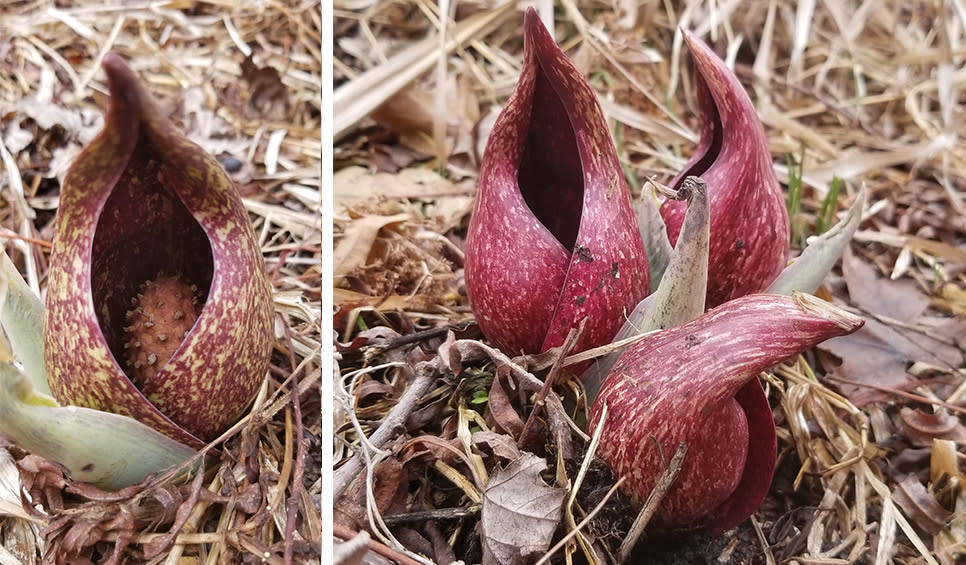After a long gray Indiana winter, it’s a real joy to smell skunk cabbage (Symplocarpus foetidus), one of Indiana’s native, fascinating flowers. The name says it all – it does not smell like roses! But seeing and smelling skunk cabbage is a sure-fire, sweet sign that spring weather is near.
Kankakee Sands land steward Olivia Schouten was tromping through Nature Conservancy owned land adjacent to Willow Slough Fish and Wildlife Area when she stumbled upon a patch of nearly 500 skunk cabbage plants growing in the wet woods.

What a surprising and fragrant find! For a flower that smells so badly to our human noses, skunk cabbage ranks high on the conservation scale and is considered a “fancy-plant,” indicative of a high-quality natural area.
Skunk cabbage is one of Indiana’s earliest flowering native plants, blooming from February through the first part of May. Once the weather begins to warm, it nearly jumps out of the ground. Skunk cabbage grows so quickly that it generates enough heat to melt the snow around it!
It has a unique growth pattern - sending up its flower before the leaves. The flowering structure is comprised of many tiny four-petaled yellow flowers that cover the surface of a globular stalk. This stalk sits right at ground level and is cloaked in a maroon speckled, thick and fleshy four-inch tall hoodlike bract that surrounds the flower.
Only after the skunk cabbage flowers begin to senesce, or die back, do the cabbage-like leaves emerge from the soil. These bright green, eight-inch wide, egg-shaped leaves are on long one-foot stalks and emit a cabbage like smell when crushed.
Flies and gnats are the primary pollinators of skunk cabbage, lured not only by the smell but by the warmth of the flower amidst the surrounding cold.
Skunk cabbage is not the only Indiana flower to rely on flies for pollination. Jack-in-the-pulpit, carrion flower, and pawpaws are also fly-pollinated. They all have the following characteristics in common: a flower that is maroon or dark in color; a light flecking or mottling to the flower structure; and a putrid odor that smells of rotting meat, dung, sap or blood.
In addition to Kankakee Sands, there are many other locations across Indiana and beyond to look for skunk cabbage. Try looking in such enchanting places as wet woods, seeps, bogs, fens and swamps where there is shade and moist ground. Skunk cabbage can be found from Ontario and Quebec, southward to Tennessee and North Carolina.
Thursday, April 22nd is Earth Day. In honor of our planet Earth, head outside to see and smell the natural world around you. There is so much diversity in our natural world for us to experience and appreciate… the good smelling things and the not-so-good smelling things. It’s all worth smelling, especially the skunk cabbage!
The Nature Conservancy’s Kankakee Sands is an 8,300-acre prairie and savanna habitat in Northwest Indiana, open every day of the year for public enjoyment. For more information about Kankakee Sands, visit www.nature.org/KankakeeSands or call the office at 219-285-2184.
More Nature Notes
Nature Notes: Celebrating the Magnificent Bison
- 3 min read
This October marks the ninth year that bison have graced and grazed our Kankakee Sands prairies. Even after…
Nature Notes: Bison, by the Numbers, at Kankakee Sands
- 4 min read
It’s that exciting time of the year when the bison calves are born! At the close of 2020, we had 93…
Nature Notes: Hoary Vervain at Kankakee Sands
- 3 min read
A Crowd Pleaser I overlook things all the time – but insects don’t. I walk, bike and drive…
Nature Notes: Chatty Little Grasshopper Sparrows at Kankakee Sands
- 4 min read
Header photo by Kathy Malone Nature isn’t always what it seems – a chatty little…
Nature Notes: The Smell of Spring - Skunk Cabbage at Kankakee Sands
- 3 min read
After a long gray Indiana winter, it’s a real joy to smell skunk cabbage (Symplocarpus foetidus), one…
Nature Notes: Growing the Fancy Plants at Kankakee Sands
- 5 min read
Trudging through the cold north winds on an early March morning, icy rains slashing my face, I make my way…
Nature Notes: I Love Winter at Kankakee Sands
- 3 min read
Photo by Jessica Gomez TNC With its short days, grey skies and cold temperatures, February in Indiana can…
Nature Notes: Crossing Those Lines - Migrating Monarchs
- 3 min read
Photos by Trevor Edmonson This past September, upwards of 2,000 monarchs congregated on the oak trees growing…
Nature Notes: Grounded - Leopard Frogs at Kankakee Sands
- 4 min read
Northern leopard frogs are fast, real fast! They aren’t called leopard frogs for nothin’. They…
Nature Notes: One Bat, Two Bat at Kankakee Sands
- 3 min read
This spring we were delighted to look up and find that our furry, winged, big brown bat mascot was hanging…













